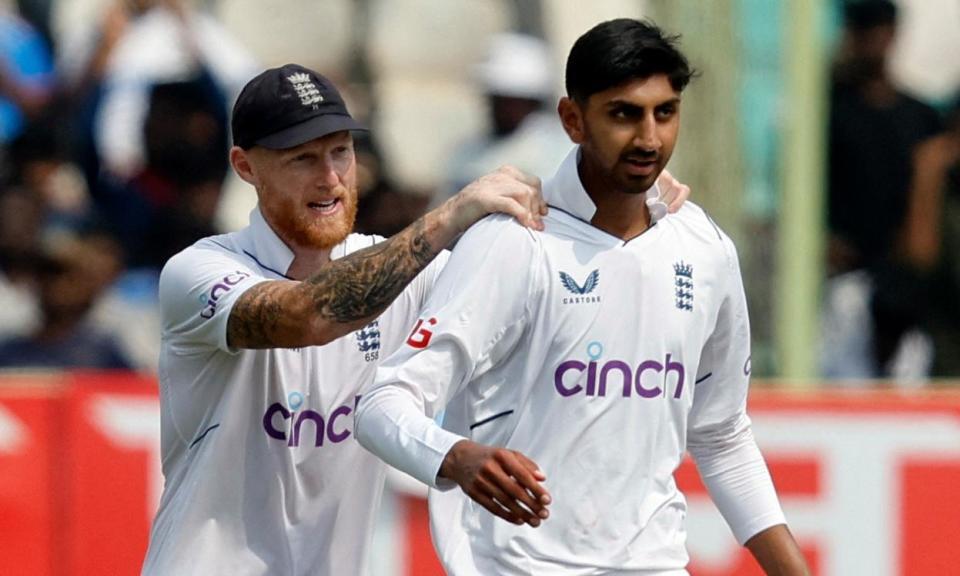
There was a fun moment in the evening gloom in Ranchi, as Shoaib Bashir prepared to bowl the fourth ball of his 31st consecutive over, shortly before the end of the most epic-scale sporting day of his young life to date.
As the left-hander Kuldeep Yadav took guard, with India 216-7 and blocking out for stumps, Bashir decided to run in not just around the wicket, but to snake in between umpire and stumps in the classic style, memories of puce, flannel-shirted 1970s left-arm twirlers of the pre-modern age flickering suddenly across the stage, oh my John Childs and Phil Edmonds of long ago.
Related: Shoaib Bashir takes four wickets as England seize control against India
As showboating goes, it’s not exactly the scorpion kick, the no-look pass or the flying dismount. We’re talking off-spin bowling here, a nagging, long-form kind of art for people prone to agonising over finger callouses and tiny margins in length.
But it still felt like a telling little kick of the heels. Perhaps the most transformative element of the Bazball years is not the aggressive batting but England’s rare sense of life in the field, the ability to constantly find new angles of attack; and to do so without letting the pressure drop or lapsing into what middle-aged cricket enthusiasts doing their best to keep up are bound to describe as “funkiness”.
Nothing much happened. Bashir chewed his gum, frowned – he has a great frown – dipped the ball on to that lovely nagging length, ended the day with four wickets, 32 overs, a 2.6 economy rate, and seemed, in the middle of all that heat and light to feel absolutely no sense of vertigo whatsoever.
It is a well-worn backstory by now. Two years ago Bashir was spending his winter nights at Surrey’s indoor centre bowling at a plastic mat in an empty net, the task, presumably, to demonstrate to assorted men in black tracksuits that he could land it on the same spot repeatedly without actually dozing off from the extreme joyless tedium of the exercise.
Fast-forward past his release by Surrey, the zigzag through minor county cricket, a chance eye-catching nine-over spell against Somerset Under-18s, and Bashir’s journey reached a kind of end point on day two here.
From carpetbagging teenager to chief tormentor of India’s top order in the key Test of the winter, doing to these high-class players what R Ashwin is supposed to be doing to England, finding bounce, drift and jag from subtle changes of angle, the control of length giving him freedom to work through his variations.
There are two wider elements to Bashir’s success at this point. First, the issue of talent ID, clogs in the system that range from the eternal difficulty of judging who is actually going to be good, to the obstacles in the way of huge chunks of the population. And secondly the emotional intelligence and tactical acuity in Stokes’ captaincy of his spinners, which is unmatched in England’s modern Test history.
On the first of these, it will seem strange to the outsider that Surrey had five years to look at Bashir then decided he didn’t have a future in cricket. In their defence that era of coaches had a pretty good hit rate. Bashir was also passed on by other counties. Spin bowling is hard to judge and nurture, with lack of specialist coaches at junior level.
Still, though, the gap between what different people see is remarkable. It took Stokes catching a clipped-up cut on social media of Bashir bowling for Somerset, and then a couple of weeks with England’s coaches, to decide he was ready for one of the toughest tests in world cricket.
The day in the field also belonged to Stokes. His in-game reading of the play as sharp as ever. In mid-afternoon he did something excellent with his spinners, drying up Sarfaraz Khan’s desire to rotate the strike, putting fielders back at the right angles, reducing a man in his second Test to a fretful, stationary target. It is common to see captains bullying the opposition with their faster bowlers. Stokes did it here with his spinners.
The other side to this, the good vibrations motivational stuff, has always looked a perfect fit with a couple of gangly junior tweakers, the kind of cricketers who, historically, would need to force their way in at every level, never the show ponies or the princelings. What a feeling to have English cricket’s ultimate sigma-male throwing a brawny arm around your shoulders. Bash and Harts. Stokes loves these guys. He backs them in actions and words.
On that note there was a tell-me-the-thing-without-telling-me-the-thing element to Alastair Cook’s comments on TNT Sports at the end of day two, where he spoke enviously about the control of Stokes’ spinners, lamenting that when he was captain his spinners would always bowl one bad ball an over, to the extent Cook could feel it coming in the field.
Let’s think about how connected these things could be? Stokes laughing off long hops, saying more please, and his bowlers responding. And Cook, a more punitive captain, finding his prophecies of failure coming true. The leadership voice that sees what you can do versus the one that sees what you can’t. The player Stokes saw Bashir bowling to on social media was, as it happens, Cook. Script note: is this too obvious?
From here it seems likely there will be pressure in the fourth innings to win the Test on this pitch. Another element of the captaincy. Bashir and Hartley both know they won’t be carrying that alone.
Article courtesy of
Source link